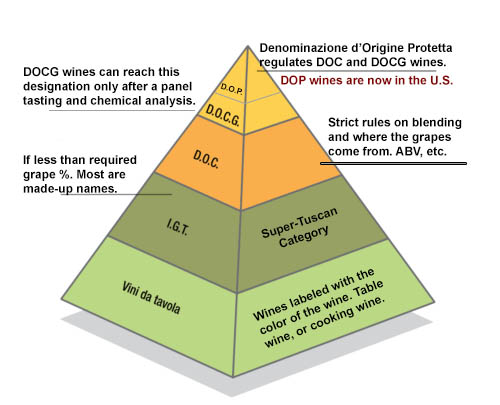D.O.P., IGT, DOC, DOCG
The D.O.P regulates all wine making activity in the DOC,
DOCG, and IGT selections. The D.O.P. acts as an umbrella
for the wines of Italy.
Denominazione di Origine Protetta
DOP is short for Denominazione di Origine Protetta
(literally “Protected Designation of Origin”).
As the the name suggests, this certification ensures that
products are locally grown and packaged with strict
adherense to all local rules of grape growing and wine
making.
An Italian wine label will usually include certain information:
the name of the winery, perhaps also the name of the vineyard
that produced the grapes, the vintage (the year in which the wine
was made), and either an abbreviation (e.g., DOC, DOCG)
or a phrase (Vino da Tavola) that indicates a category.
Have you ever wondered what a DOC wine is, and how it differs
from, for example, a Vino da Tavola?
The Four Major Categories of Italian Wine that sit under the
D.O.P. Denominazione Origine Proteta are:
- Vino da Tavola (VdT)
- Vino a Indicazione Geografica (IGT)
- Vino a Denominazione di Origine Controllata (DOC)
- Vino a Denominazione di Origine Controllata e Garantita (DOCG)
Vino da Tavola (VdT)
This literally means "table wine" and it's a wine intended for everyday
drinking, whose production process is restricted by very few rules and
regulations, other than that the stuff is not poisonous. These days,
most Italian table wines are insipid, thin, weak, and acidic, the sort of
wine that used to be sold in jugs and is now sold in Tetra Paks.
Tavernello is a good example of this type of wine.
In the past, however, there were also some spectacular Vini da Tavola,
made by extremely good producers who decided to make something
that didn't qualify for a superior status simply because of its
composition or the way it was made. For example, Tignanello VdT,
by the well-known and respected Tuscan wine producer Antinori,
was a superb red wine that contained too much Cabernet to qualify
as a Chianti Classico, thus, breaking the rules of the DOC.
Sangioveto VdT, from another renowned Tuscan producer,
Badia a Coltibuono, was named after a grape type, and therefore
couldn't be called a Chianti Classico though it was, in fact, very classic
- and very good, too.
Though most of the stellar Vini da Tavola were Tuscan, a number of
Piemontese producers began to experiment with them as well.
However, whereas Tuscans blended Sangiovese with varying
amounts of other grapes (usually Cabernet or Merlot), or vinified
French grapes by themselves (Collezione de Marchi L'Eremo,
a Syrah, or Fontodi's Pinot Noir, for example), in Piemonte they
blended Nebbiolo and Barbera, under the theory that the Nebbiolo
will supply the tannins, while the Barbera will supply acidity
(Giorgio Rivetti's Pin, for example, is wonderful).
In short, in the past, with Vino da Tavola you either got "junk"...or
something spectacular.
The Vdt made today is mostly junk, and this is because the laws were
changed to prohibit putting a vintage on VdT wines. As a result, almost
all of the quality wines that were formerly VdT are now labeled as IGT,
the few exceptions being wines made in ways not encompassed by
the IGT regulations.
For example, at least one producer in the Astigiano (a wine-producing
region in the province of Asti, in northern Italy) makes a dry Moscato
and labels it VdT because IGT regulations dictate that Moscato should
be sweet.
Vino a Indicazione Geografica (IGT)
"Geographical Indication" is a wine that is produced in a specific area.
At one time, there was nothing special about most IGT wines, though
that is no longer true -- when the laws were changed to forbid putting
the vintage (production year) on VdT wines, many producers relabeled
their alternative, "Super Tuscan," and other wines described above as
IGT.
Vino a Denominazione di Origine Controllata (DOC)
"Controlled Designation of Origin" is the Italian answer to the French
AOC (Appellation d'origine contrôlée). DOC wines are produced in
specific, well-defined regions, according to precise rules designed to
preserve the traditional winemaking practices of each individual region.
The rules for making Montepulciano d'Abruzzo DOC, for example, differ
markedly from those for making Salice Salentino DOC (from Puglia)
or Frascati DOC (from the area around Rome). The winery can state
the vineyard that the grapes came from, but cannot name the wine after
a type of grape and cannot use a name such as "Superior." Since a
wine has to meet certain quality standards to qualify as DOC, the
quality of Italian wines as a whole has improved since the first DOCs
were established in the 1960s, though in some cases the rules drawn
up by the commissions had unexpected effects
-- Super Tuscans, for example, arose from the requirement (since
dropped) that producers include white grapes in their Chianti Classico.
There are currently more than 300 Italian DOC wines.
Vino a Denominazione di Origine Controllata e Garantita (DOCG)
"Controlled and Guaranteed Designation of Origin." This quality
category is similar to the DOC but more stringent. Allowable yields
are generally lower, and DOCG wines must pass an evaluation,
analysis, and tasting by a government-licensed committee before
they can be bottled.
The establishment of DOCG wines has again resulted in an overall
improvement in the quality of Italian wines -- it doesn't make sense
for a producer whose vineyards are in a DOCG area to produce
wines that aren't good enough to qualify. There are currently about
74 Italian DOCG wines, including Barolo, Chianti Classico,
Brunello di Montalcino, Amarone della Valpolicella, and Prosecco
Superiore.

